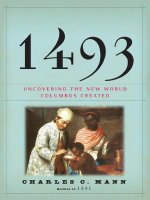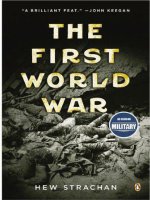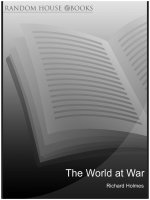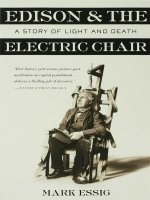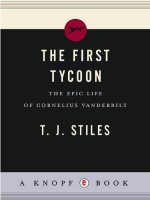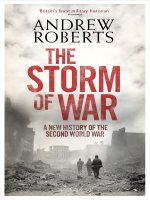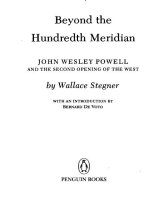David emanuel hoffman the dead hand the untold stor acy (v5 0)
Bạn đang xem bản rút gọn của tài liệu. Xem và tải ngay bản đầy đủ của tài liệu tại đây (3.92 MB, 471 trang )
Praise for David E. Hoffman’s
The Dead Hand
“A stunning feat of research and narrative. Terrifying.”
—John le Carré
“The Dead Hand is a brilliant work of history, a richly detailed, gripping tale that takes us inside the Cold War
arms race as no other book has. Drawing upon extensive interviews and secret documents, David Ho man reveals
never-before-reported aspects of the Soviet biological and nuclear programs. It’s a story so riveting and scary that
you feel like you are reading a fictional thriller.”
—Rajiv Chandrasekaran, author of
Imperial Life in the Emerald City: Inside Iraq’s Green Zone
“The Dead Hand is deadly serious, but this story can verge on pitch-black comedy—Dr. Strangelove as updated by
the Coen Brothers.”
—The New York Times
“In The Dead Hand, David Ho man has uncovered some of the Cold War’s most persistent and consequential
secrets—plans and systems designed to wage war with weapons of mass destruction, and even to place the
prospective end of civilization on a kind of automatic pilot. The book’s revelations are shocking; its narrative is
intelligent and gripping. This is a tour de force of investigative history.”
—Steve Coll, author of Ghost Wars and The Bin Ladens
“[A] taut, crisply written book…. The Dead Hand puts human faces on the bureaucracy of mutual assured
destruction, even as it underscores the institutional inertia that drove this monster forward…. A
indeed.”
ne book
—T. J. Stiles, Minneapolis Star Tribune
“An extraordinary and compelling story, beautifully researched, elegantly told, and full of revelations about the
superpower arms race in the dying days of the Cold War. The Dead Hand is riveting.”
—Rick Atkinson, Pulitzer Prize-winning
author of An Army At Dawn
“No one is better quali ed than David Ho man to tell the de nitive story of the ruinous Cold War arms race. He
has interviewed the principal protagonists, unearthed previously undiscovered archives, and tramped across the
military-industrial wasteland of the former Soviet Union. He brings his characters to life in a thrilling narrative
that contains many lessons for modern-day policy makers struggling to stop the proliferation of weapons of mass
destruction. An extraordinary achievement.”
—Michael Dobbs, author of One Minute to Midnight:
Kennedy, Khrushchev, and Castro on the Brink of Nuclear War
DAVID E. HOFFMAN
The Dead Hand
David E. Ho man is a contributing editor at The Washington Post and author of The
Oligarchs: Wealth and Power in the New Russia. He lives in Maryland.
www.thedeadhandbook.com
Also by David E. Hoffman
The Oligarchs: Wealth and
Power in the New Russia
To My Parents
Howard and Beverly Hoffman
————— CONTENTS —————
MAP
PROLOGUE
INTRODUCTION
PART ONE
1 AT THE PRECIPICE
2 WAR GAMES
3 WAR SCARE
4 THE GERM NIGHTMARE
5 THE ANTHRAX FACTORY
6 THE DEAD HAND
7 MORNING AGAIN IN AMERICA
PART TWO
8 “WE CAN’T GO ON LIVING LIKE THIS”
9 YEAR OF THE SPY
10 OF SWORDS AND SHIELDS
11 THE ROAD TO REYKJAVIK
12 FAREWELL TO ARMS
13 GERMS, GAS AND SECRETS
14 HE LOST YEAR
15 THE GREATEST BREAKTHROUGH
16 THE YEAR OF LIVING DANGEROUSLY
PART THREE
17 A GREAT UNRAVELING
18 THE SCIENTISTS
19 REVELATIONS
20 YELTSIN’S PROMISE
21 PROJECT SAPPHIRE
22 FACE TO FACE WITH EVIL
EPILOGUE
ACKNOWLEDGMENTS
ABBREVIATIONS IN NOTES
ENDNOTES
TEXT AND ILLUSTRATION PERMISSIONS
“Science has brought us to a point at which we might look forward with con dence to the conquest of
disease and even to a true understanding of the life that animates us. And now we have cracked the atom
and released such energies as hitherto only the sun and the stars could generate. But we have used the
atom’s energies to kill, and now we are fashioning weapons out of our knowledge of disease.”
—Theodor Rosebury, Peace or Pestilence:
Biological Warfare and How to Avoid It, 1949
————— PROLOGUE —————
I. Epidemic of Mystery
“Are any of your patients dying?” asked Yakov Klipnitzer when he called Margarita
Ilyenko on Wednesday, April 4, 1979. She was chief physician at No. 24, a mediumsized, one-hundred-bed hospital in Sverdlovsk, a Soviet industrial metropolis in the Ural
Mountains. Her hospital often referred patients to a larger facility, No. 20, where
Klipnitzer was chief doctor. Klipnitzer saw two unusual deaths from what looked like
severe pneumonia. The patients, he told Ilyenko, were “two of yours.” No, Ilyenko told
him, she did not know of any deaths. The next day he called again. Klipnitzer was more
persistent. “You still don’t have any patients dying?” he asked. Klipnitzer had new
deaths with pneumonia-like symptoms. “Who is dying from pneumonia today?” Ilyenko
replied, incredulous. “It is very rare.”
Soon, patients began to die at Ilyenko’s hospital, too. They were brought in
ambulances and cars, su ering from high fevers, headaches, coughs, vomiting, chills and
chest pains. They were stumbling in the hallways and lying on gurneys. The head of
admissions at Hospital No. 20, Roza Gaziyeva, was on duty overnight between April 5
and 6. “Some of them who felt better after rst aid tried to go home. They were later
found on the streets—the people had lost consciousness,” she recalled. She tried to give
mouth-to-mouth resuscitation to one ill patient, who died. “During the night, we had
four people die. I could hardly wait until morning. I was frightened.”
On the morning of April 6, Ilyenko raced to the hospital, threw her bag into her
o ce, put on her white gown and headed for the ward. One patient looked up at her,
eyes open, and then died. “There are dead bodies, people still alive, lying together. I
thought, this is a nightmare. Something is very, very wrong.”
Death came quickly to victims. Ilyenko reported to the district public health board that
she had an emergency. Instructions came back to her that another hospital, No. 40, was
being set up to receive all the patients in an infectious disease ward. The word spread
—infection!—and with it, fear. Some sta refused to report for work, and others already
at work refused to go home so as not to expose their families. Then, disinfection workers
arrived at hospital No. 20, wearing hazardous materials suits. They spread chlorine
everywhere, which was a standard disinfectant, but the scene was terrifying, Ilyenko
recalled. “There was panic when people saw them.”1
Sverdlovsk, population 1.2 million, was the tenth-largest city in the Soviet Union and
the heartland of its military-industrial complex. Guns, steel, industry and some of the
best mechanical engineering schools in the Soviet Union were Sverdlovsk’s legacy from
Stalin’s rush to modernize during World War II and after. Since 1976, the region had
been run by a young, ambitious party secretary, Boris Yeltsin.
Hospitals No. 20 and 24 were in the southern end of the city, which slopes downward
from the center. Streets lined with small wooden cottages and high fences were broken
up by stark ve-story apartment buildings, shops and schools. The Chkalovsky district,
where Ilyenko’s hospital was located, included a ceramics factory where hundreds of
men worked in shifts in a cavernous building with large, high windows.
Less than a mile away, to the north-northwest, was Compound 32, an army base for
two tank divisions, largely residences, and, adjacent to it, a closed military microbiology
facility. Compound 19, which comprised a laboratory, development and testing center
for deadly pathogens, including anthrax, was run by the 15th Main Directorate of the
Ministry of Defense. On Monday April 2, 1979, from morning until early evening, the
wind was blowing down from Compound 19 toward the ceramics factory.2
Inside Compound 19, three shifts operated around the clock, experimenting with
anthrax and making it in batches. Anthrax bacteria were grown in fermentation vessels,
separated from the liquid growth medium and dried before they were ground up into a
ne powder for use in aerosol form. Workers at the compound were regularly given
vaccinations. The work was high risk.
Anthrax is an often-fatal infection that occurs when spores of the bacteria Bacillus
anthracis enter the body, either through the skin, ingestion or inhalation. The bacteria
germinate and release toxins that can quickly bring on death if untreated. In Russia, the
disease was known as Sibirskaya yazva, or Siberian ulcer, because of the black sores that
form when it is contracted through cuts in the skin. In nature, the disease most
commonly spreads through contact with infected animals, usually grazing animals such
as cows, goats and sheep, which ingest the spores from the soil. The inhalation variety is
dangerous to humans. Breathing the spores into the lungs can kill those infected if not
treated. A single gram of anthrax contains around a trillion spores. Odorless and
colorless, the spores are extremely stable, and can remain dormant for as long as fty
years or more. For these reasons, anthrax was well suited for a biological weapon.
According to one estimate, 112 pounds of anthrax spores released along a 1.2-mile line
upwind of a city of 500,000 residents would result in 125,000 infections—and kill
95,000 people.3
What exactly happened at Compound 19 is still unknown. By one account, a lter was
removed and not properly replaced, and anthrax spores were released into the air.4
To the south, sheep and cattle in villages began to die. Anthrax had been present in
rural areas in the past, although it was not common. At the same time, people started
getting sick. The rst records of those admitted to hospitals came on Wednesday, April
4, when Ilyenko got Klipnitzer’s phone call. “What was strange for us, it was mainly
men dying, not many women, and not a single child,” she said.5 Ilyenko began keeping
records of names, ages, addresses and possible reasons for the deaths, but she didn’t
know what was happening, or why.
On April 10, as the crisis deepened, Faina Abramova, a retired pathologist who had
been a lecturer at the Sverdlovsk Medical Institute, was summoned to Hospital No. 40
and asked to autopsy a thirty-seven-year-old man who died over the weekend. He had
been at Compound 32, the army base with the tank divisions, for reserve duty, gone
home to a nearby village and, for no apparent reason, became suddenly ill. Abramova,
a spirited professional, was puzzled by the case. The man did not show classic signs of
in uenza and pneumonia. But the autopsy showed infection of the lymph nodes and the
lungs. Abramova had also noticed the man su ered from cerebral bleeding, a distinctive
red ring around the brain known as “cardinal’s cap.”6
“We started thinking what other diseases may cause this pathology,” she recalled. “We
looked up the books, and we went through them all together, and it looked like
anthrax.”
That evening, Abramova attended a reception, which was also attended by Lev
Grinberg, her protégé, a young pathologist with thick glasses, black hair and a beard. As
they danced at the reception, Abramova whispered to him that she had autopsied the
man earlier that day, and diagnosed his death as anthrax. Grinberg was stunned. “I
asked, where in our godforsaken Sverdlovsk can we have anthrax?” he recalled.
The next day, Grinberg saw the evidence for himself. He was instructed to go to
Ilyenko’s hospital. “I saw a horrible picture,” he recalled. “It was three women, they had
identical changes, sharp hemorrhagic changes in their lungs, in the lymph nodes, and
the tissue of lymph nodes was hemorrhaging.” Abramova took samples and materials
from the autopsies.
Word of the outbreak reached Moscow. Late on April 11, Vladimir Nikiforov, a chief
of the infectious diseases department at the Central Postgraduate Institute, located
within the Botkin Hospital in Moscow, arrived in Sverdlovsk. Also arriving in the city
was Pyotr Burgasov, the Soviet deputy minister of health, who had once worked at
Compound 19, in the 1950s. On April 12, at 2 P.M., Nikiforov assembled all the doctors
who had been involved and asked for their observations and the autopsies. Abramova
was last to speak. She told him: anthrax.
Nikiforov, an eminent, courtly scientist who had studied anthrax throughout his
career, announced that he agreed with her. He reassured the doctors it could not spread
from human to human. But from where had it come? Burgasov declared the source was
contaminated meat from a village located 9.3 miles from the city. No one spoke up. No
one knew for sure; the uncertainty was frightening.
In Chkalovsky’s neighborhoods, residents were told to watch out for contaminated
meat. A widespread vaccination program began; according to Ilyenko’s notes, 42,065
people were vaccinated in the days that followed. Broadsheet lea ets dated April 18
were distributed warning people not to buy meat outside the stores, to watch out for
anthrax symptoms such as headaches, fever, cold and cough followed by abdominal
pains and high temperatures, and not to slaughter animals without permission.7
Buildings and trees were washed by local re brigades, stray dogs shot by police and
unpaved streets covered with fresh asphalt.
Ilyenko wrote in her notes on April 20, “358 got sick. 45 died. 214 in Hospital 40.”
She was not asked to relinquish her notes, and kept them at home. The 45 who died at
her hospital were only part of the story; the total number of deaths from anthrax was
more than 60 people.
Carried by the steady wind, the spores oated through the ceramics factory, south of
Compound 19. Vladlen Krayev, chief engineer, was present when the outbreak began
among his 2,180 employees. He recalled that the factory had a ventilator that sucked air
from outside, pumping it into furnaces, and provided ventilation for the workers. In the
first weeks, about eighteen factory workers died. The crisis stretched on for seven weeks,
much longer than might be expected, given the two-to-seven-day incubation period for
anthrax described in textbooks at the time.8
Grinberg recalled that Nikiforov made an unusual decision, ordering that all the dead
be autopsied even though government regulations prohibited autopsy for anthrax
victims because the spores can spread. As Grinberg and Abramova worked through the
long days, the two pathologists began to take notes out of sight. They wrote these notes
on cards, and sometimes they wrote the o cial reports on carbon paper and kept the
copies. “No one checked,” Abramova recalled. The head of the regional health
department came and told them “not to talk too much about it, and don’t discuss it on
the phone.”
They conducted forty-two autopsies. They saw anthrax had damaged the lungs and
lymph nodes. Grinberg said he suspected inhalation anthrax but didn’t know for sure.
“Perhaps we didn’t know de nitely, but we were not talking about it much. Honestly
speaking, we were very tired, it was hard work, we had a feeling, myself for example,
as if we were working under war conditions. They were feeding us, bringing us meals,
to the center at No. 40. There was a huge amount of chlorine. Disinfection was done
every day. And we were going home on the trams after the working shift, and people
were rushing away because we smelled of chlorine. The way I remember it, on the 10th
day, about the end of the second week, we were thinking about keeping this material,
that it should be preserved and studied.”
Although it was prohibited, Grinberg persuaded a friend who was a photographer to
secretly take color photographs of the autopsies using East German slide lm. Abramova
also preserved tissue samples.
In May, as the crisis eased, Nikiforov assembled all those who had participated in the
hospital work and told them: the anthrax had come from tainted meat. But quietly, he
told Abramova to keep investigating. He played a double game. In public, he was an
o cial of the state, and loyal to the o cial story. But he also gave the pathologists a
private signal to hide and protect their evidence. Nikiforov later died of a heart attack.
“We are certain that he knew the truth,” Grinberg said.9
But the people of the Soviet Union and the outside world did not.
II. Night Watch for Nuclear War
The shift change began at 7 P.M. on September 26, 1983. Stanislav Petrov, a lieutenant
colonel, arrived at Serpukhov-15, south of Moscow, a top-secret missile attack earlywarning station, which received signals from satellites. Petrov changed from street
clothes into the soft uniform of the military space troops of the Soviet Union. Over the
next hour, he and a dozen other specialists asked questions of the outgoing o cers.
Then his men lined up two rows deep and reported for duty to Petrov. Their twelve-hour
shift had begun.10
Petrov settled into a comfortable swivel chair with arms. His command post
overlooked the main oor of the early-warning station through a window. In front of
him were telephones to connect to headquarters and electronic monitors. Out on the
oor, beyond the specialists and their consoles, a large map covered the far wall. At the
center of the map was the North Pole. Above the pole and beyond it—as it might be
seen from space—were Canada and the United States, inverted. Below the pole
stretched the vast lands of the Soviet Union. This was the path that nuclear missiles
would take if ever launched. The map showed the location of Minuteman missile bases
in the United States. Petrov knew those bases held one thousand intercontinental
ballistic missiles carrying nuclear warheads that could cross the Arctic and reach the
Soviet Union in thirty- ve minutes. On the main oor, a dozen men monitored
electronic consoles with a singular mission: using satellites to spot a launch and give the
leaders of the Soviet Union an added margin of ten minutes’ warning, or maybe twelve
minutes, to decide what to do.
Petrov, forty-four, had served in the military for twenty-six years, rising to deputy
chief of the department for combat algorithms. He was more of an engineer than a
soldier. He liked the logic of writing formulas, often using English-based computer
languages. On most days, he was not in the commander’s chair but at a desk in a nearby
building, working as an analyst, responding to glitches, ne-tuning the software. But
twice a month, he took an operations shift in order to keep on top of the system.
When Petrov rst arrived eleven years earlier, the station was new, with equipment
still in crates and the rooms empty. Now, it had grown into a bristling electronic nerve
center. Seven satellites orbiting above the earth were positioned to monitor the
American missile elds, usually for a period of six hours. Each satellite was a cylinder
six feet long and ve feet around, and sent streams of data to the command center.11
The brain of the center was the M-10, the best supercomputer that existed in the Soviet
Union, which analyzed the data and searched for signs of a missile attack.
The satellite system was known as Oko, or “Eye,” but the individual spacecraft were
known to Petrov by simple numbers, one through nine. On this night, No. 5 was
reaching the highest point of its orbit, about 19,883 miles above the Earth. From space,
it scanned the very edge of the Earth, using infrared sensors to detect a missile launch.
The satellite could spot the heat given o by a rocket engine against the black
background of space, a delicate trick requiring the satellite to be in the right position,
steady and aimed at the distant point where the Earth met the darkness of the cosmos.
Of the whole eet, No. 5 had the highest sensitivity, but its task was complicated by the
time of day. The satellite was aimed at missile elds that were passing from daylight to
twilight during Petrov’s shift. Dusk was often a blurry, milky zone that confused the
satellites and computers. The operators knew of the challenge, and watched closely.
Usually, each satellite picked up fteen or twenty objects of interest, and the
computers at Serpukhov-15 examined the data on each, checking against the known
characteristics of a rocket are. If it did not look like a missile, the objects would be
discarded by the computer and a new target grabbed for examination. The computer ran
continuous checks against the data streaming in from space. The satellites also carried
an optical telescope, with a view of the Earth. This was a backup, allowing the ground
controllers to visually spot a missile attack, but the images were dim—in fact, special
operators had to sit in a darkened room for two hours so they could see through the
telescopes.
On this night, satellite No. 5 was bringing in more data than usual. Instead of fteen
to twenty targets, it was feeding the computer more than thirty. Petrov gured the
elevated levels were due to the satellite’s heightened sensitivity. They watched it closely
as it approached the apogee of its orbit, when it would be positioned to monitor the
American missile fields. At 10 P.M., Petrov paused for tea.
Petrov and his men had watched many test launches from Vandenberg Air Force Base
in California and from Cape Canaveral in Florida, as well as Soviet test launches from
Plesetsk in northern Russia. With the satellites, they could rapidly detect the rocket’s
bright flare moments after it rose into the sky; they had seen a few tests fail, too.
For all the years Petrov worked at the early-warning center, they had been rushed.
The satellite system was put into service in late 1982, even though it was not ready.
Petrov and his men were told: it was an important project for the country, don’t worry
about the shortcomings. They will be xed later, you can compensate for the problems,
look the other way for now. Petrov knew why they were in such a hurry. The United
States and the Soviet Union threatened each other with missiles on hair-trigger alert.
The two superpowers had between them about 18,400 nuclear warheads poised to be
launched from missiles in silos, on submarines hidden under the seas and from bombers.
And there were many smaller, or tactical, nuclear weapons arrayed along the front lines
of the Cold War confrontation in Europe. In the event of a nuclear attack, a decision
whether to retaliate would have to be made in minutes, and enormous e orts were
made by each superpower to gain precious time for warning. With ground-based radar
alone, which could not see beyond the curvature of the Earth, the incoming missiles
might not be detected until the nal seven to ten minutes of their ight. But with the
early-warning satellites, a launch could be spotted sooner. The Americans already had
stationed their satellites to watch over the Soviet missile elds. The Soviet Union was in
a hurry to catch up. They rushed to build Serpukhov-15 and launch their own satellites.
A fear haunted the old men who ruled the Soviet Union, led by General Secretary Yuri
Andropov, a frail and paranoid former KGB chief who in the autumn of 1983 was
su ering from kidney failure. The fear was a sudden attack that might destroy the entire
leadership in Moscow before they could leave the Kremlin. If they could be decapitated,
wiped out without warning by a surprise attack, their threat to retaliate was simply not
credible. That is why Petrov’s mission was so important. The satellites, the antennas, the
computers, the telescopes, the map and the operations center—they were the night
watch for nuclear war.
Petrov heard the rhetoric, but he didn’t believe the superpowers would come to blows;
the consequences were just too devastating. Petrov thought the Soviet leaders were
pompous and self-serving, and—in private—he was disdainful of the party bosses. He
did not take seriously their bombast about America as the enemy. Yet the furor in recent
months had been hard to ignore. President Ronald Reagan had called the Soviet Union
an “evil empire” in March, and only a few weeks before Petrov’s night at the operations
center, Soviet Air Defense Forces had shot down a Korean airliner in the Far East, killing
269 people.
Petrov saw himself as a professional, a technician, and took pride in overcoming long
odds. He understood the enormity of the task, that in early warning there could be no
room for false alarms. His team had been driven hard to eliminate the chance for error.
While they had tried strenuously to make the early-warning system work properly, the
apparatus was still troubled. A system to make decisions about the fate of the Earth was
plagued by malfunctions. Of the rst thirteen satellites launched in the test phase from
1972 to 1979, only seven worked for more than one hundred days.12 The satellites had
to be launched constantly in order to keep enough of them aloft to monitor the
American missile fields. They often just stopped sending data back to Earth.
At 12:15 A.M., Petrov was startled. Across the top of the room was a thin, silent
panel. Most of the time no one even noticed it. But suddenly it lit up, in red letters:
LAUNCH.
A siren wailed. On the big map with the North Pole, a light at one of the American
missile bases was illuminated. Everyone was riveted to the map. The electronic panels
showed a missile launch. The board said “high reliability.” This had never happened
before. The operators at the consoles on the main oor jumped up, out of their chairs.
They turned and looked up at Petrov, behind the glass. He was the commander on duty.
He stood, too, so they could see him. He started to give orders. He wasn’t sure what was
happening. He ordered them to sit down and start checking the system. He had to know
whether this was real, or a glitch. The full check would take ten minutes, but if this was
a real missile attack, they could not wait ten minutes to nd out. Was the satellite
holding steady? Was the computer functioning properly?
As they scrambled, Petrov scrutinized the monitors in front of him. They included data
from the optical telescope. If there was a missile, sooner or later they would see it
through the telescope. Where was it headed? What trajectory? There was no sign of it.
The specialists who sat in the darkened room, also watching the telescope, spotted
nothing. The computer specialists had to check a set of numbers spewing out of the
hard-copy printer. Petrov scrutinized the data on his monitor, too. Could it be a
technical error?
If not, Petrov ran through the possibilities. If just one missile, could it be an accidental
or unauthorized launch? He concluded it was not likely. He knew of all the locks and
precautions—and just one person could not launch a missile. Even the idea of two
o cers conspiring to launch a missile seemed impossible. And if one missile was
launched, he thought, what did that mean? This was not the way to start a nuclear war.
For many years, he had been trained that a nuclear war would start only with a massive
strike. He said it again, to himself: this is not the way to start a nuclear war.
He had a microphone in one hand, part of the intercom system to the main floor. With
the other hand, he picked up the telephone to call his commanders, who oversaw the
whole early-warning system, including the separate radars. Petrov had to quickly reach
his own conclusion; the supervisors would want to know what was happening. He had
not completed his own checks, but he could not wait. He told the duty o cer, in a
clipped tone: “I am reporting to you: this is a false alarm.”
He didn’t know for sure. He only had a gut instinct.
“Got it,” the officer replied. Petrov was relieved; the officer did not ask him why.
The phone was still in his hand, the duty o cer still on the line, when Petrov was
jolted again, two minutes later.
The panel ashed: another missile launched! Then a third, a fourth and a fth. Now,
the system had gone into overdrive. The additional signals had triggered a new
warning. The red letters on the panel began to ash MISSILE ATTACK, and an
electronic blip was sent automatically to the higher levels of the military. Petrov was
frightened. His legs felt paralyzed. He had to think fast.
Petrov knew the key decision-makers in a missile attack would be the General Sta .
In theory, if the alarm were validated, the retaliation would be directed from there.
Soviet missiles would be readied, targets fed in and silo hatches opened. The Soviet
political leadership would be alerted. There would be only minutes in which to make a
decision.
The siren wailed. The red sign flashed.
Petrov made a decision. He knew the system had glitches in the past; there was no
visual sighting of a missile through the telescope; the satellites were in the correct
position. There was nothing from the radar stations to verify an incoming missile,
although it was probably too early for the radars to see anything.
He told the duty officer again: this is a false alarm.
The message went up the chain.
————— INTRODUCTION —————
This book is the story of people—presidents, scientists, engineers, diplomats, soldiers,
spies, scholars, politicians and others—who sought to brake the speeding locomotive of
the arms race. They recoiled from the balance of terror out of personal experience as
designers and stewards of the weapons, or because of their own fears of the
consequences of war, or because of the burdens that the arsenals placed on their
peoples.
At the center of the drama are two key gures, both of them romantics and
revolutionaries, who sensed the rising danger and challenged the established order.
Mikhail Gorbachev, the last leader of the Soviet Union, abhorred the use of force and
championed openness and “new thinking” in hopes of saving his troubled country.
Ronald Reagan, fortieth president of the United States, was a master communicator and
beacon of ideals who had an unwavering faith in the triumph of capitalism and
American ingenuity. He dreamed of making nuclear weapons obsolete, once and for all.
They were not alone. Many others with imagination, determination, guile and
conscience sought to rein in the danger. The goal of the book is to tell the story of how
the Cold War arms race came to an end, and of its legacy of peril—and to tell it from
both sides. Too often in the past, the history has been obscured by American
triumphalism, which re ected only one side, or by secrecy and disinformation in
Moscow, which masked what really happened inside the Soviet Union and why. With
fresh evidence, it is now possible to see more clearly the deliberations that unfolded
behind closed doors in the Kremlin during Gorbachev’s tumultuous rule. It was there, in
arguments, meetings, documents and phone calls, that Gorbachev, deftly maneuvering
and cajoling, faced o against the entrenched and powerful forces of the militaryindustrial complex and began a radical change in direction. It was there Gorbachev
decided to abandon whole missile systems; turn the Soviet Union away from global
confrontation; cut military spending and troops in Europe; and take the blueprint for a
colossal Soviet “Star Wars” missile defense system, which designers and engineers had
laid on his desk, and bury it in his bottom drawer. It is also possible with the new
evidence, especially diaries and contemporaneous documents, to see more clearly how
Gorbachev and Reagan viewed each other, how their perceptions fed into actions and
how they wrestled with their own internal con icts, ideology and an enormous stockpile
of mistrust to lead the world, haltingly, out of the years of confrontation.
While nuclear weapons were the overwhelming threat of the epoch, another
frightening weapon of mass casualty was being grown in asks and fermenters. From
1975 to 1991, the Soviet Union covertly built the largest biological weapons program in
the world. Soviet scientists experimented with genetic engineering to create pathogens
that could cause unstoppable diseases. If the orders came, Soviet factory directors were
ready to produce bacteria by the ton that could sicken and kill millions of people. The
book explores the origins and expansion of this illicit, sprawling endeavor, for which
Russia has yet to give a full accounting.
Much of the writing about the end of the Cold War stops at the moment the Berlin
Wall fell in November 1989, or when the Soviet ag was lowered on the Kremlin in
December 1991. This book attempts to go further. It begins with the peak of tensions in
the early 1980s, leads us through the remarkable events of the Reagan and Gorbachev
years and then shows how the Soviet collapse gave way to a race against time, an
urgent search for the nuclear and biological hazards that were left behind.
The book will begin with the “war scare” of 1983, a period of confrontation, anger and
danger. But to understand it, we must rst see the gathering storm in the decades that
preceded it, a great contest of wills, a duel of deterrence. The atomic bomb was never
used in combat in the Cold War between the United States and the Soviet Union, 1947–
1991. Rather, the two sides held each other in a balance of terror by deploying
thousands of nuclear weapons on missiles, submarines and strategic bombers. Over
decades, the danger intensi ed as the weapons were invented and reinvented to carry
enormous destructive power, enhanced by ever-faster delivery, superaccuracy and
invulnerability.
In the words of one of the early nuclear strategists, Bernard Brodie, the atomic bomb
was the “absolute weapon” that would change warfare forever.1 The bomb greatly
increased the chance that it would be regular people who would die at the start. As a
group of six Harvard professors put it in a study in 1983: “For the rst time in history,
nuclear weapons o er the possibility of destroying a country before one has defeated or
destroyed its armed forces.” And nuclear war would certainly come faster than any war
in history. It might be over in a matter of hours. It might start before leaders could
rethink their decisions or change their minds. It could lead to the death of millions of
people even before a false alarm was discovered to be false.2
At the outset of the Cold War, the United States threatened the Soviet Union with a
single, devastating blow aimed at cities and industry. The rst American nuclear
weapons each weighed thousands of pounds, and were to be carried by lumbering
strategic bombers that would take hours to reach their targets. By contrast, a half
century later, the warhead on a missile could be delivered across oceans in thirty
minutes. Rear Admiral G. P. Nanos, director of Strategic Systems Programs in the U.S.
Navy, said in 1997 that if one drew a circle with a radius the length of the Trident
submarine—560 feet—the warheads on a Trident II D5 missile could be accurately
targeted into that circle from a distance of four thousand nautical miles.3
But this achievement in power and deadly accuracy inspired a profound dread among
those who might one day have to press the button launching those missiles.
In the United States, a master plan for carrying out a nuclear war was rst drafted in
1960, at the end of President Dwight Eisenhower’s term. The scope of the Single
Integrated Operational Plan was awesome. Given adequate warning time, the United
States and allies would launch their entire strategic force of about 3,500 nuclear
weapons against the Soviet Union, China and satellite states. Eisenhower dispatched his
science adviser, George B. Kistiakowsky, to the headquarters of the Strategic Air
Command in O utt, Nebraska, on November 3–5, 1960, to study the newly drafted plan.
Kistiakowsky reported back that the plan would “lead to unnecessary and undesirable
overkill.” Eisenhower con ded to Captain E. P. “Pete” Aurand, his naval aide, that the
estimates—the sheer number of targets, the redundant bombs for each—“frighten the
devil out of me.”4
President John F. Kennedy was no less unsettled. Briefed on the war plan on
September 14, 1961, he commented afterward to Secretary of State Dean Rusk, “And we
call ourselves the human race.”5
Kennedy and his defense secretary, Robert S. McNamara, were uneasy with the
Eisenhower-era idea of massive retaliation. They felt the threat of a single, enormous
nuclear strike did not t the more fragmented and complex competition they faced with
the Soviet Union as tensions ared rst over Berlin and then over Cuba. When the war
plan was revised in the spring and summer of 1962, the new plan gave the president
more exibility and choices in waging a possible nuclear attack, including the ability to
hold back forces in reserve, to avoid population centers and industry and to leave out
some countries as targets. A key feature of the new plan, put into e ect just before the
Cuban missile crisis of October 1962, was to aim largely at Soviet weapons, and not at
cities and industry, an idea known as counterforce. If one thinks of cocked pistols aimed
at each other, counterforce was an effort to shoot the gun out of the hand of the enemy.6
It seemed to be more humane to aim at missiles rather than cities, but counterforce also
raised deeply disturbing questions. Could it make the use of nuclear weapons more
tempting, since it implied a limited nuclear strike was possible? And to be successful,
would the counterforce option have to be carried out rst—to shoot before you were
shot, to preempt an attack? This was the haunting fear of many decades to come, the
idea of a disarming, bolt-from-the-blue first strike.
While Kennedy wanted to spare the cities, McNamara realized over time that it was
impossible to aim at every Soviet weapon without unleashing an expensive new round
of the arms race, an escalation with no end in sight. As a result, McNamara shifted to a
strategy that he called “assured destruction,” which required building the number of
weapons needed to destroy 20 to 25 percent of the Soviet population and 50 percent of
the industrial base. McNamara capped the number of Minuteman missiles to be built at
one thousand. His analysts concluded, “The main reason for stopping at 1,000
Minuteman missiles, 41 Polaris submarines and some 500 strategic bombers is that
having more would not be worth the cost.” McNamara hoped that the Soviets would also
reach a plateau—and stop building.7 A critic of McNamara proposed adding “mutual” to
“assured destruction” and the idea of Mutual Assured Destruction, known pointedly as
MAD, was born. For many Americans, this idea of equal vulnerability and mutual
deterrence came to define the Cold War.8
Locked in global confrontation, the United States and the Soviet Union were each rooted
in centuries of radically di erent history, geography, culture and experience. Peering
through a veil of suspicion, the superpowers often wrongly judged each other’s
intentions and actions. They engaged in deceptions that only deepened the dangers. As
the Harvard professors observed in 1983, “The United States cannot predict Soviet
behavior because it has too little information about what goes on inside the Soviet
Union; the Soviets cannot predict American behavior because they have too much
information.”
An early but telling example was the so-called missile gap. The Soviet Union
announced on August 26, 1957, the rst test of an intercontinental ballistic missile at
full range, and successfully launched the world’s rst arti cial satellite, Sputnik, into
orbit on October 4. For the next four years, Premier Nikita Khrushchev misled the West
with claims that the Soviet Union was turning out missiles “like sausages,” that supermissiles were in “serial production” and “mass production.” John F. Kennedy raised
alarms about the “missile gap” in his 1960 campaign, but found out that it didn’t exist.9
Khrushchev had concealed weakness—by bluffing.
A disaster was narrowly averted in the Cuban crisis of October 1962, when
Khrushchev took an enormous gamble by stationing nuclear weapons and missiles on
the island. The brinksmanship ended as both Kennedy and Khrushchev exercised
restraint. But long after Khrushchev withdrew the weapons, and after his ouster in 1964,
the Cuban crisis lingered in the minds of Soviet leaders, who feared inferiority to the
United States. Starting in the mid-1960s, Soviet missile production zoomed upward;
hundreds were rolled out every year.
The Soviet Union, looking through an entirely di erent prism than the United States,
saw nuclear weapons as a blunt instrument for deterrence. If attacked, they would
respond with crushing punishment. By many accounts, in the early decades they did not
adopt the limited nuclear options that were embraced in the United States; they thought
that the use of even one atomic bomb would trigger escalation, so they prepared for allout war.10 They did not put much stock in the American idea that mutual vulnerability
could lead to stability. They feared both powers would be constantly striving to get
ahead, and they threw their resources into the quest. When the Soviet Union nally
reached approximate parity with the United States in the early 1970s, the thinking
began to change. Instead of threatening a preemptive rst strike, as in the earlier years,
they moved toward a posture of preparing for assured retaliation, a second strike. At
this time they also began the rst strategic arms control negotiations with the United
States, and détente blossomed.11
The Soviet buildup was driven by a powerful and hidden force, the defense
industrialists. Leonid Brezhnev ruled by consensus over a dysfunctional group of aging
sycophants, and by the mid-1970s, Brezhnev was in such ill health that he largely ceased
to lead. The industrialists lled the vacuum. They had great in uence over what
weapons would be produced, by some accounts even more than the military. A striking
example was the climax of an intense internal con ict over the next generation of
intercontinental ballistic missile. In July 1969, at a vacation lodge near Yalta, a vexed
Brezhnev assembled his top military leaders and missile designers. The competition
pitted two of the most storied designers, Mikhail Yangel and Vladimir Chelomei, against
each other. Yangel proposed a four-warhead missile, the SS-17, designed to t in newly
constructed, hardened silos, best to ensure retaliation if the Soviet Union were attacked,
but expensive. Chelomei had initially proposed to upgrade his older SS-11 missile in
existing silos, which were not hardened, but o ered the military more warheads more
cheaply, perfect for threatening a preemptive rst strike at the enemy. At the time of
the Yalta meeting, Chelomei shifted gears and proposed a new missile, the SS-19, with
six warheads, which would also require new, expensive hardened silos. Mstislav Keldysh,
president of the Academy of Sciences, who had Brezhnev’s con dence, was appointed to
head a commission to resolve the dispute. At Yalta he took the oor and lamented that
in all the rush to build missiles, the country had not even decided on a strategic doctrine:
whether the purpose was to threaten a rst strike, or to preserve the force for
retaliation. But Keldysh could not settle the rivalry. In the end, all three missile options
were approved at great cost, the kind of decision that would eventually bankrupt the
Soviet Union.12
In the 1970s, the United States began to deploy a Minuteman III missile that could
carry up to three warheads instead of just one. The new device was called a Multiple
Independently-targetable Re-Entry Vehicle, or MIRV, and it would allow each of the
three warheads to aim at separate targets, leading to a new surge in the size of the
arsenals. The Soviets matched and surpassed this technology, and in the mid-1970s
began the deployment of a new generation of land-based missiles. One of them, the SS18, could carry a payload seven to eight times as large as the American missile. In fact,
there were plans at one point to put as many as thirty-eight warheads atop each giant
SS-18.
As the arsenals grew, so did the complexity of the U.S. war plan. On January 27,
1969, a week after taking o ce, President Richard Nixon went to the Pentagon for a
brie ng on the Single Integrated Operation Plan (SIOP). “It didn’t ll him with
enthusiasm,” recalled Henry Kissinger, then Nixon’s national security adviser and later
secretary of state. In the event of nuclear war, Nixon was told, he would have three
functional tasks: Alpha, for strikes on the most urgent military targets; Bravo, for
secondary military targets; and Charlie, for industrial and urban targets. If the president
ordered an attack of Alpha and Bravo, urban areas would be spared. All three would
mean total war. But the choices Nixon would face in an emergency were mindnumbingly complex. There were ve attack options constructed from the three main
tasks, and as many as ninety lesser variations.13 On May 11, 1969, Nixon ew on the
National Emergency Airborne Command Post, a Boeing 707 lled with communications
gear, and participated in a nuclear war exercise. His chief of sta , H. R. Haldeman,
wrote in his diary, “Pretty scary. They went through the whole intelligence and
operational brie ngs—with interruptions, etc. to make it realistic.” Haldeman added
that Nixon “asked a lot of questions about our nuclear capability and kill results.
Obviously worries about the lightly tossed-about millions of deaths.”14
The same fears troubled Soviet leaders. In 1972, the General Sta presented to the
leadership results of a study of a possible nuclear war after a rst strike by the United
States. They reported: the military had been reduced to one-thousandth of its strength;
80 million citizens were dead; 85 percent of Soviet industry was in ruins. Brezhnev and
Prime Minister Alexei Kosygin were visibly terri ed by what they heard, according to
Adrian Danilevich, a general who took part. Next, three launches of intercontinental
ballistic missiles with dummy warheads were planned. Brezhnev was provided a button
in the exercise and he was to push it at the proper moment. Defense Minister Andrei
Grechko was standing next to Brezhnev, and Danilevich next to Grechko. “When the
time came to push the button,” Danilevich recalled, “Brezhnev was visibly shaken and
pale and his hand trembled and he asked Grechko several times for assurances that the
action would not have any real world consequences.” Brezhnev turned to Grechko and
asked, “‘Are you sure this is just an exercise?’”15
Recognizing the overwhelming destructive power of nuclear weapons, Nixon decided in
1969 that the United States would renounce biological weapons. In 1972, more than
seventy nations, including the Soviet Union and the United States, signed the Biological
and Toxin Weapons Convention, a four-page international agreement banning the
development and production of biological weapons, and the means of delivering them.
The treaty entered into force in 1975. But the Soviet Union promptly betrayed its
signature on the treaty. Brezhnev approved a secret plan to covertly expand Soviet
germ warfare e orts under the cover of a civilian enterprise. The Soviet program grew
and grew into a dark underside of the arms race.
The biological weapons treaty came at the peak of détente, Nixon’s policy to wrap the
Soviet Union in a web of new international agreements and understandings that would
make the Cold War manageable and less threatening. A centerpiece of détente was the
signing of the SALT I agreement in Moscow on May 26, 1972, by Nixon and Brezhnev.
The most signi cant part of this agreement was the Anti-ballistic Missile Treaty, which
e ectively ended the prospect of an expensive arms race in missile defenses. 16 But on
o ensive arms, the long-range missiles that were growing in size and destructive
capacity, the SALT I agreement was basically just a stopgap measure. It froze xed
launchers for land-based and submarine-based missiles on each side, but included no
precise numbers of missiles or warheads to be frozen. The core argument for the SALT I
treaty and détente was that equal levels of missiles and launchers were not as important
as the overall strategic balance, and in that the two sides were roughly equal. If the
United States stopped the cycle of building new missiles, the reasoning went, it was
likely the Soviets would too. Kissinger said, “And one of the questions which we have to
ask ourselves as a country is what in the name of God is strategic superiority? What is
the signi cance of it, politically, militarily, operationally, at these levels of numbers?
